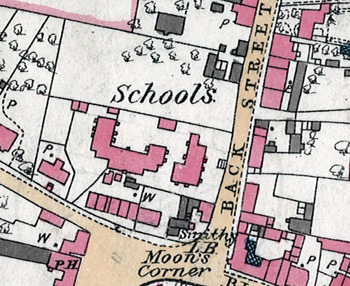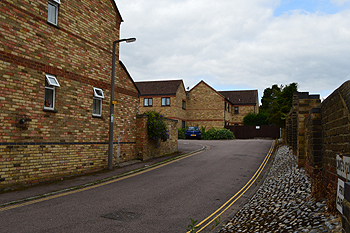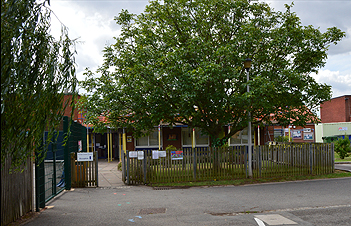Potton Primary Schools
![The schools about 1900 [Z50/91/59]](/CommunityHistories/Potton/Images/The schools about 1900 [Z50-91-59].jpg)
The schools about 1900 [Z50/91/59]
On 19th February 1875 Potton became the 26th School Board formed in the county. School Boards were established by the Elementary Education Act 1870. This was, in part, the beginning of the secularisation of education in this country. School Boards were groups of representatives, elected by the local ratepayers and the Board had the powers to raise funds to form a local rate to support local education, build and run schools, pay the fees of the poorest children, and make local school attendance compulsory between the ages of 5 and 13. They were intended to replace church and chapel schools or provide a school where no school had previously been.

The schools on a map of 1884
Potton had a number of small schools but, as the vicar acknowledged in his reply to the questionnaire sent out about the 1870 Act there was “no efficient school” and accommodation was needed for 210 juniors and 140 infants. The Potton School Board was dominated by nonconformists and raised sufficient money to build two schools in Chapel Street which opened in 1876; one was for infants and the other for juniors. In 1885 the junior school split into separate departments for boys and girls.
A land mark Education Act was passed in 1902, coming into effect in 1903. It disbanded the School Boards and gave day to day running of education to newly formed Local Education Authorities, usually the county council, as in Bedfordshire. The old Board Schools thus became Council Schools. In 1904 the separate departments for boys and girls united to form a junior mixed school once more.
Bedfordshire and Luton Archives and Records Service has a scrapbook of cuttings of visits made to most Bedfordshire Schools by School Inspectors for a period from just before the First World War through the inter-war years [E/IN1/1]. Both the infants’ and junior schools have two inspection reports before they were reorganised in 1925. The infants’ department was visited on 18th July 1911 when average attendance was 139. The inspector wrote: “The results of the instruction are probably as good as can be reasonably expected considering the disadvantageous circumstances under which the work is carried on. Owing to inadequate floor space free movements cannot be indulged in and the physical needs of the children do not receive proper attention. In both rooms useless galleries take up much needed floor-space, there is no effective separation of the classes in the main room and some of the desks used by the First Class are unsuitable, the children being compelled to adopt unhygienic postures when using them. The brightness and life which could characterise a good Infants’ School are, therefore, absent and despite the good intentions and hard work of the Teachers there is much left to be desired which the Local Education Authority alone can render possible by providing more suitable and adequate accommodation”.
The junior school was visited the following year: average attendance was 261. “This Department has been visited several times since it was last reported upon, and on every occasion it was found in a thoroughly satisfactory condition. The organisation is skilful, the methods are good, and in all the classes the teachers work conscientiously and well, and the children make good progress. The First Class is exceptionally well taught. If arrangements could be made for the older boys to have lessons in Woodwork, the usefulness of the School would be much increased”. The schools were not visited again until well after the Great War. The juniors were visited in November 1922 and January 1923 when average attendance was 260. The report read: “During the past two or three years there has been a considerable number of changes and at times a shortage of Staff and the work of the school suffered to some extent. The Staff now seems a settled one, the changes which have been made within the last three or four months are all to the good, and a forward movement may be expected. Details of the work at the present moment are as follows”.
“Arithmetic is good in Classes I and II; it is weak – but with every prospect of improvement – in Class III, and also in a considerable section of Class IV. Writing is good on the whole in the two upper classes, and mostly satisfactory in the two middle, but in the bottom classes it is in many cases quite capable of improvement. Composition (Classes I and II) is fully of average merit. Reading is hardly above fairly good in the bottom class, and speech needs some attention; it is better in Class V – which is a little noisy at times – and really good in Class IV, where distinctness of speech is a marked feature. Recitation is distinctly above average. Geography (Class I) is in most respects good on the whole, but History is less satisfactory; in Class II both these subjects were far from strong when the present teacher came, but here again there is a good prospect of improvement. Drawing is good in Classes I and II but only fairly good in Classes III and IV. Physical Exercises were inspected in four classes; in Classes II and III they are capably handled and promise well, Class IV is satisfactory on the whole, Class V is fairly good. Much of the Singing is very creditable, but rather more progress might be made in the middle part of the school”.
The infants’ school was visited in November 1922 when average attendance was 122: “This school is going on well. The first class is very capably taught; the children are trained to deal with difficulties as they arise, receiving from the Teacher just the right kind of help. They make good progress especially in Reading. Handwork also is good, and Singing is thoroughly enjoyed. The second and third classes are making adequate headway – and the lowest class is very suitably handled. The teaching throughout the school is thoroughly kindly and the general atmosphere is bright and cheerful”.
In 1925 the junior school broke, once more, into separate departments for boys and girls and the infants were added en bloc to the girls department. In 1925 the school premises were inspected. “Both departments need redecoration. In the Boys’ Department the centre of the room used by Classes 4 and 3 is very dark. Additional light, and additional hopper openings for ventilation are wanted here. There is an offensive collection of decaying rubbish just over the wall which, at a distance of 5 or 6 feet divides the S. side of the school from the offices and coppers of some cottages. The smell from it is unpleasant and enters the S. windows in the boys’ Department. In the Girls’ department the stove pipe in the room used by Standards III and IV is broken. The cloak room is rather overcrowded and clothes overhang. I should draw attention to the possible danger to the girls in Standards I, II and III if by any chance a fire broke out; there is only one exit: a door into the cloak room might prove very useful”.
The boys’ school was visited in January 1928 when average attendance was 122. “The present Headmaster took charge of this department when the school was re-organised three years ago. He has introduced a new spirit, quickened the life of the school and laid the foundations of a new tradition. Organisation and supervision are efficiently carried out and the teaching is effective. Judging from examinations the general standard of work reaches a satisfactory level. The boys show keen interest in their studies, they are responsive in oral lessons, and they work assiduously in private study. Tone is good, and the future of the school under its present direction appears very promising. It is hoped that a new Centre for Handicraft and Domestic Subjects may be provided here before long”.
Despite the hope for “a new tradition” there was no real time for one to develop. The rather retrograde distinction between boys on one hand and girls and infants on the other, was swept away in 1931 when the schools were reorganised again, this time as a mixed junior and a mixed senior school. Both schools were visited in 1937 and the report on the junior school read: “This school has six classes with 193 children on the books; four of these classes are under one roof, the other two are in different parts of the Senior School building across the playground. There is no hall and no free room that can be utilised as such. The school, is well organised. Teachers and children appear happy and interested in their work and satisfactory results are obtained. The Speech Training deserves special commendation. New methods, involving training on individual lines in Number, reading and some written work were introduced last year. Useful records of individual progress are also kept. It is pleasing to note that some of the apparatus has been made by the teachers themselves. The progress of this work will be watched with interest. The children are well behaved; the older ones take responsibility for a number of small duties and perform them with quiet efficiency. The attention of the Managers is drawn to the dirty state of the school floors”.
The third of the great Education Acts was that of 1944 which established the principle of County Primary Schools for children up to the age of 11, at which time they took an examination to determine the nature of the secondary school they would attend until they were 15, the most academically able going to grammar schools, the rest to secondary or secondary modern schools. Potton Council Junior School thus became Potton County Primary School.

The site of the old Potton schools August 2013
In the 1970s Bedfordshire County Council introduced comprehensive education, doing away with the 11+ examination and grammar schools and introducing a tier of school between the old County Primary and County Secondary Schools. Thus Lower Schools now taught children aged 4 to 9, Middle Schools from 9 to 13 and Upper Schools from 13 onwards. The only school left in Potton, the county primary, thus became a lower school and moved to new premises in Everton Road which was built in 1973. The old school in Chapel Street continued to be used for some activities until closure in 1980. It was demolished in 1982 and houses now stand on the site. The school house, however, 14 Station Road, remains.

Potton Lower School August 2013